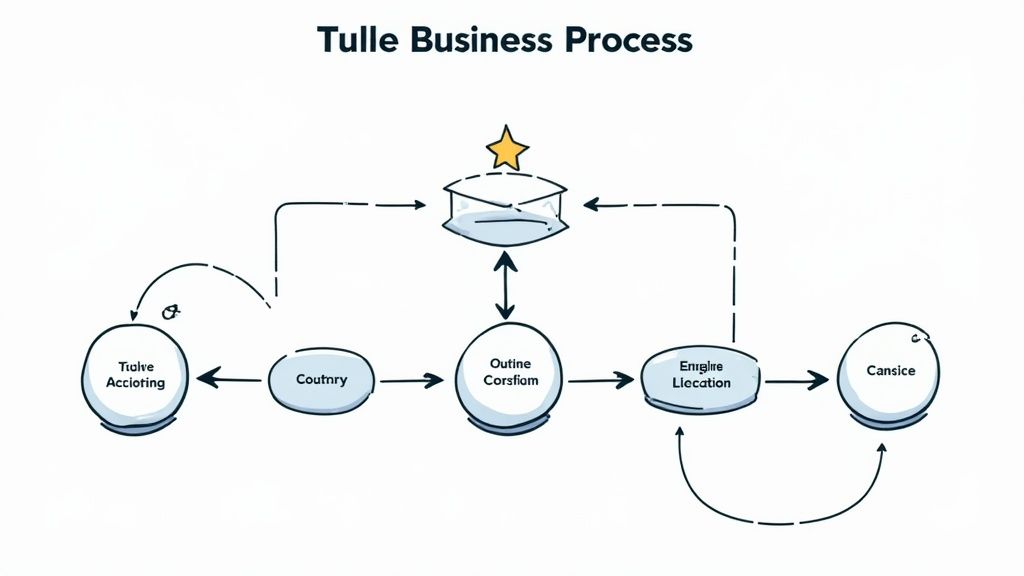How to Streamline Business Processes: Expert Guide
Understanding Process Optimization That Drives Growth
Process optimization is essential for creating lasting business success. When you improve your operations systematically, you can achieve better results while using fewer resources. Rather than implementing isolated fixes, it's crucial to evaluate how each change affects your entire business system and contributes to key objectives.
Identifying Areas for Process Improvement
To optimize effectively, start by thoroughly analyzing your current workflows. Look for bottlenecks, redundancies, and opportunities to improve efficiency. Your business processes are interconnected - when one area underperforms, it impacts everything downstream. Regular process audits help identify these weak points before they cause wider disruption.
Each process should connect directly to specific, measurable business goals. This focus ensures your optimization efforts drive real results. By understanding exactly what outcomes you want to achieve, you can prioritize changes that will have the biggest positive impact. This strategic approach helps maximize the return on your process improvement investments.
How Process Improvements Drive Business Growth
Companies that implement Business Process Management (BPM) solutions see an average 20% reduction in costs, according to research by IDC. These savings come from more efficient workflows, automated tasks, and reduced waste in labor and materials. Learn more about business process management statistics. The benefits go well beyond just saving money.
Benefits of Business Process Optimization
Increased Efficiency
Faster turnaround times, improved productivity
Low to Medium
Reduced Costs
Lower operating expenses, improved profitability
Low to Medium
Improved Employee Morale
Increased job satisfaction, reduced stress
Medium to High
Enhanced Customer Experience
Better service delivery, increased customer loyalty
Medium to High
When you optimize your processes, teams can accomplish more in less time. This increased efficiency reduces workplace stress and improves employee satisfaction. Better processes also lead to smoother customer interactions and higher satisfaction rates, which helps grow revenue. The overall impact is a stronger, more competitive business positioned for long-term success.
Breaking Down Process Bottlenecks That Kill Productivity
Understanding and fixing bottlenecks makes all the difference in improving business processes. A bottleneck occurs when work gets stuck at a particular point, slowing down everything that follows - similar to how one accident can back up an entire highway. Finding and fixing these choke points is key to better productivity.
Identifying Bottlenecks Through Process Audits
Smart companies run detailed process audits to find productivity problems that often go unnoticed. Just as a mechanic inspects a car's engine piece by piece, a process audit examines each step of your operations to spot slow-downs and backups. This hands-on approach reveals exactly where improvements will make the biggest difference.
Practical Techniques for Gathering Actionable Data
Good data is essential for finding real solutions. This means:
Creating detailed workflow maps
Measuring how long each step takes
Tracking error rates and quality issues
Getting direct input from team members
Team feedback often reveals issues that numbers alone can't show. By looking at both data and employee experiences, you get the full picture of what's really happening in your processes.
Prioritizing Improvements for Maximum Impact
Some bottlenecks cause bigger problems than others. Once you spot the issues, use the Impact/Effort Matrix to decide what to fix first:
High
Do First
Plan Carefully
Low
Quick Wins
Low Priority
Focus on high-impact, low-effort fixes first - these give you the most benefit for your time and resources. This practical approach helps you make smart choices about where to invest your improvement efforts.
Transforming Operations Through Strategic Automation

Smart automation is about picking the right targets, not automating everything. The key is identifying which processes would benefit most from automation while keeping human oversight where needed. Take data entry - perfect for automation. But complex decisions often work best with a mix of automated tools and human judgment.
Let's look at how different automation approaches compare in practice:
Data Entry
40 hrs/week
4 hrs/week
$2,800/month
Report Generation
25 hrs/week
2 hrs/week
$1,750/month
Invoice Processing
30 hrs/week
3 hrs/week
$2,100/month
Customer Support
45 hrs/week
15 hrs/week
$2,400/month
Identifying Automation Opportunities
The first step is spotting the right processes to automate. Look for tasks that are:
Repetitive: Regular tasks like data entry or report creation
Rule-Based: Activities with clear steps and predictable results
High Volume: Work involving lots of data or frequent repetition
Time-Consuming: Tasks that take up significant staff time
Research shows real benefits - 70% of C-level executives report spending 10% to 40% of their time on basic tasks that could be automated. Learn more about BPM statistics.
Choosing the Right Automation Tools
After identifying targets, pick tools that fit your needs. Key factors include:
Integration: Must work smoothly with your current systems
Scalability: Able to grow with your business
User-Friendliness: Easy for staff to learn and use
Cost-Effectiveness: Benefits should outweigh the investment
Good integration means using the right mix of APIs, custom connections, and built-in tools to make everything work together smoothly.
Implementing and Maintaining Automation
Success requires more than just installing software. You need:
Clear workflows: Written steps for each automated process
Staff training: Help your team use the new systems effectively
Performance tracking: Measure the impact on key goals
Regular updates: Keep improving processes as needs change
This focused approach helps ensure your automation efforts deliver real, lasting improvements to your business.
Leading Change That Actually Sticks
Making real changes in business processes requires more than just rolling out new systems. The key is creating an environment where teams genuinely embrace improvements. Without strong leadership and team support, even the best processes will likely fizzle out.
Building Stakeholder Buy-In
The first step is helping everyone understand why changes matter. Show your team how better processes will make their daily work easier by removing tedious tasks and letting them focus on more meaningful work. Being open and transparent builds trust and reduces pushback.
Understanding Team Dynamics
Changes can shake up established ways of working. Get key team members involved early in planning improvements. Listen to their input, address their worries, and show them how new processes will help them work better. Having teams help map out processes gives them ownership and valuable insights.
Clear Communication is Key
Keep everyone informed with regular updates as you roll out changes. Offer training sessions and make support resources easily available. This helps people feel confident using new workflows and minimizes disruption.
Working Through Resistance
It's normal for people to resist change at first. Take time to hear and address concerns. Present changes as improvements that will help everyone work more effectively. Give people the training and support they need to feel comfortable with new processes. Plan ahead for potential issues so implementation goes smoothly. Like tending a garden, building a culture of improvement takes consistent care and attention.
Measuring Success Beyond Basic Metrics

Making business processes more efficient requires more than just automation. You need clear ways to measure if your improvements are actually helping your business goals. While metrics like task completion time matter, they only tell part of the story. The real value comes from understanding how these changes impact key business outcomes like revenue growth and customer happiness.
Establishing Meaningful Benchmarks
Start by setting clear reference points for your key metrics before making any changes. Think of these measurements as your starting line - they help you track real progress over time. Having solid baseline data lets you clearly demonstrate the impact of your process improvements through concrete before-and-after comparisons.
Implementing Effective Monitoring Systems
Getting useful insights requires reliable ways to track your progress. This could mean using specialized software tools, setting up regular reporting processes, or combining multiple tracking methods. The goal is to collect accurate, consistent data that shows what's really happening in your operations. Good monitoring helps you understand which changes are working and where you need to make adjustments.
Adjusting Strategies Based on Real Performance Data
Making processes better is an ongoing journey, not a one-time fix. Be ready to change course based on what your data tells you. If something isn't working as planned, step back and try a different approach. For example, if automating a task isn't reducing errors like you hoped, you might need to provide more staff training or fix issues with the automation tool itself.
Frameworks for Continuous Evaluation
Build systems to regularly review and improve your processes. This means consistently checking your metrics, getting feedback from your teams, and making needed updates. Obsibrain can help by providing a central place to:
Track improvement progress
Manage process-related tasks
Keep changes aligned with business goals
Regular evaluation helps your processes stay effective as business needs change. This active approach means your efficiency efforts keep delivering real benefits over time instead of becoming outdated.
Building a Culture of Continuous Improvement

Making business processes better isn't something you do once and forget about. It's an ongoing effort that requires commitment and focus. When companies make process improvement part of their everyday operations, they stay competitive and efficient over the long term.
Developing Process Champions Within Your Teams
A proven approach is to identify process champions in each department. These are regular team members who care deeply about making things work better. They spot opportunities for improvement, gather input from coworkers, and help put new processes into action. When leadership is shared this way, everyone feels responsible for making positive changes.
Implementing Effective Feedback Loops
Good feedback systems are essential for ongoing improvement. Teams need clear ways to share ideas about making processes better. This could be through:
Regular meetings focused on process discussions
Simple online forms for suggestions
Dedicated workshops for process improvement
Open channels where people feel comfortable sharing thoughts
For instance, some companies use special online tools where employees can submit ideas. A team reviews these suggestions, tests out the best ones, and measures their impact.
Adapting to Changing Business Needs
As markets and customer needs change, your processes need to keep up. Regular reviews help ensure your methods still match your goals. Sometimes this means adding new tools, changing how work flows, or completely redoing certain processes.
Think of your processes as works in progress rather than finished products. Keep testing and adjusting them through scheduled reviews and ongoing feedback from your teams.
Sustaining Momentum and Delivering Long-Term Value
To keep improvement efforts going strong, make sure to:
Celebrate wins when processes get better
Thank process champions for their work
Share positive results with everyone
Show how better processes help the whole company
When everyone sees the real benefits of their efforts, they stay excited about making things work better.
Looking to improve your business processes? Obsibrain helps teams track progress, manage tasks, and keep improvements on target. Visit us to learn more about making your workflows more efficient.
Last updated
Was this helpful?